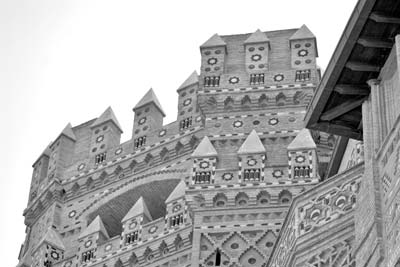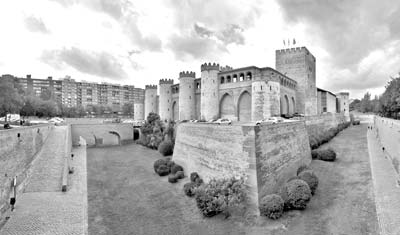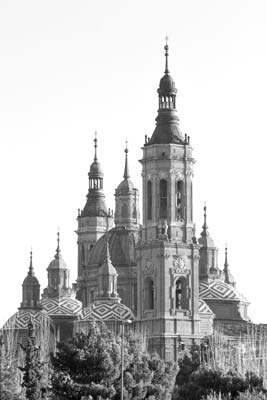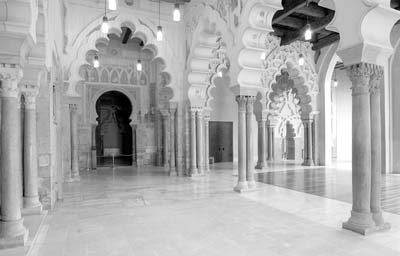Terminus Zaragoza
by Jay Brunhouse
When you first step off your Spanish high-speed Talgo 350 train and out of Zaragoza’s (Saragossa’s) 2003 Delicias Station, the first thing you see 2,000 feet across the River Ebro are the risings of pavilions, towers and exhibitions sponsored by more than 78 countries for Zaragoza’s 2008 World Expo, June 14 to Sept. 14.
Fluvi, the expo’s mascot (sort of a smiling drop of water with big eyes), will oversee the mammoth show dedicated to “Water and Sustainable Development.” Engineers will raise an aerial gondola and two bridges from Delicias Station to the site to serve a good number of the 7.5 million visitors expected by the organizing committee.
The easy connections from Madrid and possibly Barcelona by high-speed trains, as well as scheduling during the period when most visitors arrive in Spain, when the days are longer with more hours of sunlight and when the summer evenings invite people to be outdoors, all combine to guarantee healthy attendance.
This extravaganza will introduce visitors to the historical sights and superb gastronomy of Spain’s fifth-most-populous city. Currently, Zaragoza, the capital of Aragon, boasts 200 historical sites and 45 monuments.
Zaragoza (pop. 680,000) is a warm, brown city formed between two cathedrals and spreading down into the Ebro River basin. Its 2,000-year history means that you can see reminders of some of the greatest historic and artistic legacies in Spain.
Historic art
Signs of the city’s founding, when the city was named after Roman Emperor Augustus, are still visible 2,000 years later. Visitors photograph the ruins of the Roman Forum, thermal baths, the river port and the Great Theater.
During the Muslim occupation of Spain, their Moorish architects erected the enormous Aljaferia Palace. After the Reconquest, the edifice was rearranged and served as the palace for Aragon kings and Catholic monarchs before being taken over by the Inquisition and converted to barracks. After its recent restoration, the palace sparkles with dazzling tracery, curved capitals, multilobed arches and floral decorations, making it a marvelous example of Mudéjar art.
Mudéjar Architecture of Aragon was inscribed by the UNESCO World Heritage Center in 1986. Its development in the 12th century resulted from the particular political, social and cultural conditions that prevailed in Spain after the Reconquest. This art, influenced by Islamic tradition, also reflected contemporary European styles, particularly the Gothic. Present until the early 17th century, Mudéjar is characterized by an extremely refined and inventive use of brick and glazed tiles in architecture, especially in the belfries.
The Aragon kings, after freeing the city from the Moors, proclaimed Zaragoza as their capital. The city, however, jealous of its autonomy, voted itself the most democratic in all of Spain and increased its prosperity through wise administration and establishment of a commercial exchange. Tolerant by tradition, it protected its Muslim masons, who were skilled in brickwork, and the Mudéjar style flourished, especially in church embellishments.
Zaragoza’s resistance before Napoleon’s army in the terrible years 1808-09 shows the determination for independence of those of the now autonomous region of Aragon, Spain. In June 1808, Napoleon’s siege was lifted and the Aragonese sang, “The Virgin of Pilar will never be French.” Sadly, the French returned and half of the inhabitants (54,000) died by combat, famine and epidemics.
Zaragoza of song
In James Michener’s only travel book, “Iberia,” he quotes from a zarzuela (brief light opera) as follows:
“At last I look upon you, famous Ebro… Once more I tread the soil of Zaragoza; there is the Seo and there the Pilar.”
The Ebro, of course, is Zaragoza’s river; La Seo and Pilar both were cited by the UNESCO World Heritage Center in 2001.
Zaragoza’s first cathedral, the Cathedral de San Salvador, commonly known as La Seo, is the most significant and most historical building in Aragon, representing medieval, Renaissance and Baroque styles. When it was extended, at the height of Zaragoza Mudéjar at the end of the 15th century, Aragonese masters in collaboration with their counterparts from Seville turned a simple brick wall into a true multicolored tapestry.
Zaragoza is known worldwide for the Baroque Pilar Basilica, the other of Zaragoza’s two cathedrals and, for 2,000 years, a destination for Christian pilgrims of all denominations. On Jan. 2, A.D. 40, according to tradition, the Virgin appeared miraculously to comfort the Apostle James, and left on the site the venerated pillar.
Its chapel is virtually a miniature church in its own, built around the original site of the miraculous pillar, which resides in a niche supporting the Virgin, who appears as a tiny Gothic statue haloed in precious stones. Priests change the symbol’s dress daily. Pilgrims line to kiss the jasper pillar through an aperture at the back of the chapel.
The basilica also features two mural frescoes painted by the young Goya.
Renaissance Zaragoza
From the period of Renaissance, a multitude of palatial houses reflects the sumptuousness of Zaragoza in the 15th century. Museums, such as the one dedicated to sculptor Pablo Gargallo, and exhibitions of Aragonese art represent the period.
The dramatic Argillo Palace is an example of Renaissance palaces between 1659 and 1661. It was declared a National Monument in 1943. The façade shows the characteristic use of facing bricks, and the gallery impresses with false arches and jutting wooden eaves, which are highlighted by the translucent roof over the central courtyard, which was installed in 2001.
It is home to the Pablo Gargallo Museum. The Zaragoza artist worked successively through periods of copper, lead, bronze and iron creations. After his death, his heirs donated for the museum 82 sculptures, 70 drawings, 12 sets of cardboard templates and biographical materials repeating Gargallo’s themes and media.
Foodie city
Zaragoza is well known for its impressive cuisine. One can enjoy the results of fusion at any of the many restaurants, cafés and bars, which has meant that tapeo (going for tapas) is considered a “must do” in Zaragoza. The main areas in which tapas are turned into an art form are the Old Town, the Center and the University Zone.
Informal tapas restaurants such as Casa de Comida la Republicana, Café de Levante, Cerveceria Mayor, Café Babel, Bar Restaurante Antiguo Paraíso, Pizzeria Augusta, Taberna Doña Casta, Bar La Tasquillia de Pedro and La Bodeguilla de Santa Cruz, as well as Azoque Restaurant, are a great treat. Las Carboneras features a dinner-and-flamenco show popular with tourists.
I thank the Tourist Office of Spain, Chicago (312/642-1992, www.spain.info), and the Zaragoza Tourist Board (phone [0034] 902 201 212, www.zaragozatourismo.es) for arranging my visit to Zaragoza. We stayed at the 4-star Hotel Catalonia Zaragoza Plaza (phone 34-976-205858, www.hoteles-catalonia.com), with rooms from €82 (near $109). It is centrally located near the Pilar Basilica amidst a swarm of restaurants featuring delicious tapas.




